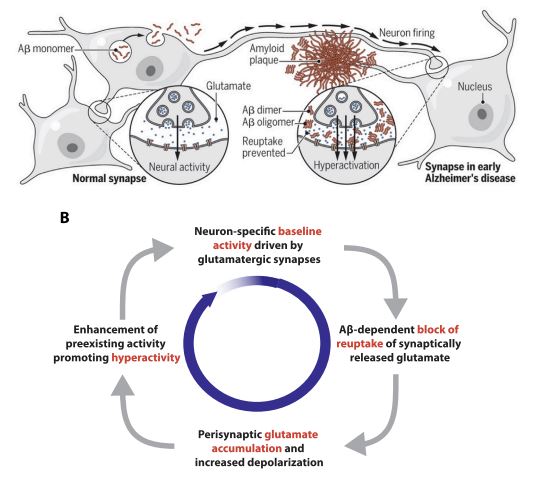 One of the hallmarks of Alzheimer’s disease (AD) is structural cell damage and neuronal death in the brains of
affected individuals. As these changes are irreversible, it is important to understand their origins and precursors
in order to develop treatment strategies against AD. Here, we review evidence for AD-specific impairments of
glutamatergic synaptic transmission by relating evidence from human AD subjects to functional studies in animal
models of AD. The emerging picture is that early in the disease, the accumulation of toxic ?-amyloid aggregates,
particularly dimers and low molecular weight oligomers, disrupts glutamate reuptake, which leads to its
extracellular accumulation causing neuronal depolarization. This drives the hyperactivation of neurons and
might facilitate neuronal damage and degeneration through glutamate neurotoxicity. One of the hallmarks of Alzheimer’s disease (AD) is structural cell damage and neuronal death in the brains of
affected individuals. As these changes are irreversible, it is important to understand their origins and precursors
in order to develop treatment strategies against AD. Here, we review evidence for AD-specific impairments of
glutamatergic synaptic transmission by relating evidence from human AD subjects to functional studies in animal
models of AD. The emerging picture is that early in the disease, the accumulation of toxic ?-amyloid aggregates,
particularly dimers and low molecular weight oligomers, disrupts glutamate reuptake, which leads to its
extracellular accumulation causing neuronal depolarization. This drives the hyperactivation of neurons and
might facilitate neuronal damage and degeneration through glutamate neurotoxicity.
|
 One of the hallmarks of Alzheimer’s disease (AD) is structural cell damage and neuronal death in the brains of
affected individuals. As these changes are irreversible, it is important to understand their origins and precursors
in order to develop treatment strategies against AD. Here, we review evidence for AD-specific impairments of
glutamatergic synaptic transmission by relating evidence from human AD subjects to functional studies in animal
models of AD. The emerging picture is that early in the disease, the accumulation of toxic ?-amyloid aggregates,
particularly dimers and low molecular weight oligomers, disrupts glutamate reuptake, which leads to its
extracellular accumulation causing neuronal depolarization. This drives the hyperactivation of neurons and
might facilitate neuronal damage and degeneration through glutamate neurotoxicity.
One of the hallmarks of Alzheimer’s disease (AD) is structural cell damage and neuronal death in the brains of
affected individuals. As these changes are irreversible, it is important to understand their origins and precursors
in order to develop treatment strategies against AD. Here, we review evidence for AD-specific impairments of
glutamatergic synaptic transmission by relating evidence from human AD subjects to functional studies in animal
models of AD. The emerging picture is that early in the disease, the accumulation of toxic ?-amyloid aggregates,
particularly dimers and low molecular weight oligomers, disrupts glutamate reuptake, which leads to its
extracellular accumulation causing neuronal depolarization. This drives the hyperactivation of neurons and
might facilitate neuronal damage and degeneration through glutamate neurotoxicity.